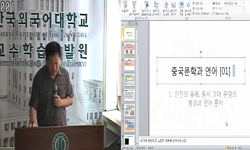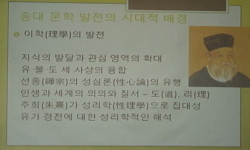본 논문의 목적은 20세기초 1900-1910 연대의 한중 신소설에 나타난 신여성상을 비교함으로써 서로의 차이점과 공통점을 찾아내어 그 시기 여성상의 시대적 특수성을 밝히는 것이다. 지금까지 ...
http://chineseinput.net/에서 pinyin(병음)방식으로 중국어를 변환할 수 있습니다.
변환된 중국어를 복사하여 사용하시면 됩니다.
- 中文 을 입력하시려면 zhongwen을 입력하시고 space를누르시면됩니다.
- 北京 을 입력하시려면 beijing을 입력하시고 space를 누르시면 됩니다.
한·중 신소설에 나타난 신여성상 비교연구 = A Comparative study of the Image of Modern Women in Korean·Chinese New Novel
한글로보기https://www.riss.kr/link?id=T8942377
- 저자
-
발행사항
[전주]: 全北大學校, 2002
- 학위논문사항
-
발행연도
2002
-
작성언어
한국어
- 주제어
-
KDC
813.000
-
발행국(도시)
대한민국
-
형태사항
vi, 94 p..
- 소장기관
-
0
상세조회 -
0
다운로드
부가정보
국문 초록 (Abstract)
본 논문의 목적은 20세기초 1900-1910 연대의 한중 신소설에 나타난 신여성상을 비교함으로써 서로의 차이점과 공통점을 찾아내어 그 시기 여성상의 시대적 특수성을 밝히는 것이다. 지금까지 한중 신소설에 대한 비교 연구는 주로 영향관계에서 진행되어 왔다. 그러나 영향관계 비교연구만으로는 소기의 목적을 달성하기 어렵기 때문에 본 논문에서는 영향관계를 전제하면서 양국 소설의 공통적 모티프를 추출하여 주제를 비교하는 방법을 선택하였다.
본론에서는 한중 신소설 작품을 분석하기에 앞서 신여성상이 형성 될 수 있었던 시대적 배경을 검토하였다. 이 시기 양국은 모두 외적으로 외세 침략의 위기에 직면하여 있었고, 내적으로는 봉건체제가 붕괴되면서 각종 사회 갈등과 충돌이 발생했으며 동시에 서양문명의 영향을 받아들이기 시작하고 있었다. 이와 같은 사회적 변동과 서구문화의 유입으로 인하여 전통사회의 윤리관과 가치관은 커다란 변모와 진통을 겪게 되는데 그 중에서도 여성관의 변화는 특히 두드러지게 나타난다. 사회상황의 변화에 힘입어 자아의식에 눈뜬 여성들은 구속적 삶에서의 해방을 요구하며 사회진출로의 통로를 개척해 나갔다. 당시의 신소설에서는 이러한 내외적 환경의 변화로 출현한 신여성들을 다루기 시작한다.
본론에서는 주로 신교육, 자유연애, 여권 찾기와 지위향상이라는 주제적 측면에서 양국 신소설에 나타난 신여성의 형상을 분석·비교하여 다음과 같은 공통점과 차이점을 추출해냈다. 먼저 신교육 문제에 있어서 양국의 신소설은 공통적으로 여성이 남성에게 예속된 원인을 여성교육의 부재에서 찾고 있다. 양국 신소설에서는 여성의 자아각성을 위해서 가장 시급한 것은 교육이라는 주제의식이 선명하게 드러나며, 이는 신식계층의 여학생과 여교사 주인공들을 통해서 다루어지고 있다. 양국 신소설의 여성 주인공들은 공통적으로 학문터득을 위하여 노력하는 모습을 보여주고 있다. 또한 여성들이 교육을 받아 자아각성에 이르고 자신의 잠재력을 발휘함으로써 여성들은 가정과 사회에서 남성과 평등한 인격을 존중받을 수 있고 나아가 사회와 국가에서 중요한 역할을 할 수 있다는 의식까지 나아가고 있다.
그러나 한국 신소설의 경우 여주인공들이 실천보다 낙관론에서 출발하여 이상과 꿈에 기대하고, 여성의 사회진출과 참여가 여성사회 내에 한정되어 있으며, 교육을 받는 궁극적인 목적이 개인 목적 달성, 즉 좋은 배필을 찾기 위한 데에 있다는 점에서 중국 신소설과 차이가 있다. 중국 신소설의 여주인공들은 교육의 중요성을 인식하여 신여성으로의 전환을 강조하고 끝까지 실천해나가는 경험을 중요시하는 점이 특징적이다. 또한 중국 신소설은 교육을 받는 목적이 개인적인 데에 그치지 않고 교육의 목적을 국가의 운명과 직결시키고, 여성성보다 국민성을 강조함으로써 성적 차별을 불식시킨다는 점에서도 한국 신소설과 차이점을 보인다. 여성 주인공의 신분에 있어서는 한국 신소설에서는 주인공이 무남독녀임을 강조하거나 몰락한 양반집의 딸로서 상류사회 여성으로 한정되어 있는데 반해서, 중국 신소설은 이에 대해 특별히 강조하지 않고 하층 여성까지 포함하는 것이 특징이다.
자유연애문제를 다룬 한중 신소설 작품들에서는 여성주인공들이 한결같이 전통적인 윤리관과 혼인제도에 반발하여 부모님의 명령을 따르지 않고 자유연애를 추구한다. 자유연애를 추구하는 미혼여성들 뿐만 아니라 연애와 재가에 대해서 개방적인 사고를 보여주는 과부도 등장한다. 특히 한국 신소설 「한의 일생」의 주인공 영애와 중국 신소설 「진가애정」의 수영이라는 인물은 이 시기의 다른 작품과 달리, 당시 윤리도덕관이나 주위 환경에서 전혀 영향을 받지 않고 완전히 자의에 따라 행동하여 더욱 근대적인 여성상을 보여준다.
그러나 한국 신소설에서는 자유연애와 과부재가를 시도한 여성들이 거의 다 행복한 결말을 맞는 반면에, 중국 신소설에서는 불가에 출가하거나 죽음에 이르는 불행한 결말을 맞는다는 점이 다르다. 이는 한국 신소설이 자유연애 문제를 다루는 데 현실성보타는 낭만적인 이상추구를 중요시했다면, 중국 신소설은 이상추구보다 현실적인 문제, '경험'에 더 무게를 두고 있는 것이라 볼 수 있다. 중국 신소설이 이러한 성향을 보이는 것은 구식가정에서 성장해서 신식교육을 받은 신소설 작가들이 신여성의 출현을 기대하면서도 동시에 그들의 출현이 전통적 사회질서를 파괴할까 염려하는 데서 기인한다.
여성의 권리 찾기와 여성의 지위 회복이라는 주제를 다룬 소설들에서는 오랫동안 봉건적 사상과 윤리의 구속과 압박을 받으며 살아온 여성주인공들이 낡은 틀을 깨뜨려 남성과 평등한 지위를 얻기 위해서, 그리고 자신의 사회적 권리와 역할을 주장하며 그것들을 쟁취하기 위해 노력한다. 여성이 사회에 참여하고 '국민'의 한 사람으로서의 의무와 역할을 수행함으로써 남녀평등을 이룰 수 있을 뿐만 아니라 국권의 회복과 국가 발전에도 도움이 될 수 있다는 주제의식은 양국의 신소설에서 똑같은 양상을 보이고 있다. 근대적 여성관의 형성 과정에서 한중 신소설의 여성상은 일정한 차이점을 보이는 데, 중국 신소설의 신여성이 여권신장과 여성해방의 실천 과정 중에서 채택한 수단과 방법이 한국 신소설의 신여성보다 훨씬 더 급진적이고 과격하다는 점이다. 중국 신소설의 경우 여성 우월주의적 성향을 보이기까지 하는데, 이는 중국 여성들이 망국 위기에 직면하여 여성들도 남성들과 더불어 혁명에 투신함으로써 민족의 위기를 극복해야 한다는 의식이 더 강렬했기 때문이다.
이상에서 한중 양국 신소설의 여성상을 비교·분석함으로써 양국 신소설의 주제의식을 살펴보았다. 이를 통해 서로 비슷한 시대상황에 처해 있던 양국의 신여성들이 자신의 새로운 삶을 개척해 나가는 과정과 이들이 신여성으로 변화해 나가는 양상을 엿볼 수 있었다.
다국어 초록 (Multilingual Abstract)
The purpose of this paper is to clarify the characteristics women of the particular era by comparing the image of modern women appeared in 1900-1910 years in the Korean-Chinese New novels. Comparative Studies between Korean and Chinese novels have be...
The purpose of this paper is to clarify the characteristics women of the particular era by comparing the image of modern women appeared in 1900-1910 years in the Korean-Chinese New novels.
Comparative Studies between Korean and Chinese novels have been carried out mainly in terms of influence so far. However, it is impossible to reach the goal of this paper only by comparing in influence relations. Therefore, I chose the method of comparing the themes by abstracting common motives from two countries' novels.
In this paper, I studied the background of the period for forming the modem image of women before analyzing the works of modern novels of Korea and China. Externally, both countries were facing the invasions by foreign powers and internally, they started to adopt the influence of Western civilization and, at the same time, various social complications and clashes were caused by the fall of feudal system.
Due to the social changes and influx of Western culture, the social value system and ethics of the traditional society underwent painful transformation. The change of views on women appeared noticeably amongst them. Eye-opened women for self consciousness with the help of social change, demanded liberation from chained life and pioneered the passageway to march towards the society. New novels at that time started treating modem women appeared with this kind of internal-external surrounding changes.
I drew the similarities and the differences of the images of the modern women reflected in the modern novels of two countries in terms of modern education, free inter-sexual relationship, feminism, and the enhancement of women's positions by analysing comparatively.
It clearly shows in the New novels of two countries that the most urgent thing for women's self-realization is the Education and this was addressed through the women characters of modern education such as students and teachers.
Those novels depicted the efforts of women characters for the academic enlightenment.
As those who are educated, reach the stage of self-awakening, women could demonstrated their potential and they could be treated equally with men at home and the society. Now they are conscious of they could play important roles in the society and the government.
However, in the case of Korean New novels, the heroins expect dream and ideal based on optimism rather than practice. Participation and advancement towards the society for women was restricted among themselves. The difference from Chinese novel is the ultimate goal of being educated is to fulfill the personal goal which is to find qualified spouse.
The distinctive points are the heroins in Chinese novels are well aware of the importance of education and emphasize the importance of converting women to modern women and those women's experience of putting new ways of thinking into practice. The purpose of the education in Chinese New novels does not stop at individual level but directly relate it to the fate of their country by stressing the citizenship rather than the feminity which overcome the gender discrimination in the process. This also shows some difference from the Korean New novels.
Regarding social status of heroin, it is stressed that she is the only daughter of a family or limited to daughters of families from declined-ruling class in Korean New novels while Chinese counterpart include women from low class as well.
Novels of both countries dealing with 'free love' depict heroins pursuing liberal relationship defying against traditional ethics and marriage system. Apart from single women who prefer 'free love’ we can also find widows with open ideas about romantic relationships and remarriage. Especially, Korean New novel, 'Han eui Ilsang' and Chinese one, 'Jin Ga Ae Jung' show more advanced women models who behave completely on the basis of their own will without being influenced by the contemporary ethics, morality, or surrounding social environment.
However, the main difference between Korean and Chinese New novels on this is that most women who attempt 'free love' or 'remarriage' end up in happiness in Korean novels while their Chinese counterparts lead to unhappy endings of becoming buddhist monks or death.
This is due to the fact that Korean novels pursue romantic ideals instead of reality when Chinese novels put more weight on the realistic aspect such as 'Experience' rather than ideals. The reason for this is Chinese New novelists who anticipate the emergence of modern women also concern about the breakdown of traditional social order by their appearance.
The novels dealing with the subject of women's right and women's status attempt to claim equal right of women by breaking down old mould of women who have suffered from suppression and confinement of feudal ideas and ethics.
Novels of both countries have the same message that women can not only accomplish the equality between men and women but also contribute to the resumption of the sovereignty and development of the country by carrying out their duties and social roles as the citizens.
The clear difference between Korean and Chinese novels on the formation of feminity is that methods for the enhancement of women's right and the liberation of women are much more radical and violent in Chinese novels than in Korean ones.
Even the women's superiority is demonstrated in the Chinese New novels which is attributed to the strong sense of obligation of Chinese women to overcome the national crisis by actively involving themselves in the revolution together with men on the verge of the collapse of their nation.
I have looked at the themes by the comparative analysis of women appeared in Korean and Chinese New novels. Through this exercise, I have noticed the process of the Korean and Chinese women's exploration toward the new ways of life and their conversion into modem women against the similar environment particular to the era.
목차 (Table of Contents)
- 목차
- Abstract = i
- I. 서론 = 1
- 1. 연구동기 및 목적 = 1
- 2. 연구사의 검토 = 4
- 목차
- Abstract = i
- I. 서론 = 1
- 1. 연구동기 및 목적 = 1
- 2. 연구사의 검토 = 4
- 1) 한국에서의 신소설 연구 = 4
- 2) 중국에서의 신소설 연구 = 7
- 3) 한국에서의 중국 소설 연구 = 10
- 4) 비교문학 관점에서의 연구 = 11
- 3. 연구범위 및 연구 방법 = 13
- II. 한·중 신여성 출현의 사회·역사적 배경 = 18
- 1. 외세의 침입과 내부 봉건 체제의 붕괴 = 18
- 2. 개화 구국운동의 전개에 따른 여권신장의 대두 = 20
- 3. 변법운동, 혁명으로의 여권에 대한 자각 확산 = 23
- III. 한·중 신소설에 나타난 신여성상 = 29
- 1. 신식 교육에 대한 지향 = 29
- 1) 신식교육과 자아각성 = 29
- 2) 새로운 지식층 여학생과 여교사의 등장 = 33
- 2. 전통 윤리관과의 충돌과 근대적 애정관의 추구 = 42
- 1) 자유연애 사상의 확대 = 42
- 2) 과부재가 문제의 제기 = 49
- 3) 자의에 따른 적극적 실천 = 52
- 3. 여성 권리회복과 지위향상에 대한 추구 = 57
- 1) 여권 찾기와 지위 향상의 실천 = 57
- 2) 혁명과 결부된 여권신장의 실천 = 62
- IV. 한·중 신여성상의 공통점과 차이점 = 69
- 1. 지위 향상을 통한 로운 삶의 개척 = 69
- 2. 관념적 한국여성과 실천적 중국여성 = 71
- V. 결론 = 79
- 국문초록 = 85
- 摘要 = 89
- 참고문헌 = 91












